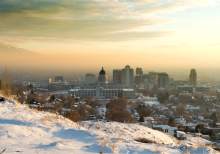This is an archived article that was published on sltrib.com in 2015, and information in the article may be outdated. It is provided only for personal research purposes and may not be reprinted.
Salt Lake City, Provo, Orem and Logan are inching up the chart of the nation's most polluted cities.
The American Lung Association's State of the Air 2015 report puts the greater Salt Lake City area at No. 7, up from No. 8 the year before, for short-term spikes in particle pollution. Logan, meanwhile, took a bigger leap, from No. 11 to No. 8 by the same measure.
It's not a good thing, said Jamie Riccobono, executive director of the American Lung Association of Utah.
"We went from bad to worse," she said. "It's scary how many bad-air days there were."
The association ranks metro areas according to levels of three kinds of pollution: year-round particulate pollution, the number of episodes of high-particle pollution and ozone pollution.
Brock LeBaron, deputy director of the Utah Division of Air Quality, noted that even though Utah cities are high on the list for short-term episodes of bad particulate pollution, no Utah city has bad air year-round. That's not the case for most of the other cities, which appear on both the short-term and year-round bad particulate pollution lists.
"Utah is different and unique," he said, with particulate and ozone pollution spikes based on the weather. "When we have an inversion, when we have snow on the ground, we're going to see high pollution," LeBaron said.
Air that's unhealthy to breathe is especially hard on the 289,284 Utahns — 11 percent of the population — with lung problems such as asthma or chronic obstructive pulmonary disease (COPD), for the very young and the old, the report notes.
Counties along the Wasatch Front — Utah, Salt Lake, Davis and Weber — and Cache County all were given "F" grades for the number of days of high particulate pollution from 2011 through 2013.
Salt Lake County had the highest weighted average number — 20.7 days — followed by Cache County, with 19.3 days. The study assigns different weights to days with more or less pollution.
Salt Lake County, with its heavy traffic, also got an "F" for the number of high-ozone days, a weighted average of 7.3 days for the three years. Duchesne and Uintah counties, where gas and oil development dominate the economy, had even more high-ozone days in the three years — 20.5 and 35.2, respectively — earning both counties "F" grades.
Uintah County was No. 7 and Duchesne No. 15 on the counties with the worst ozone nationally.
Cache County, by contrast, got an "A" grade on ozone because there was not a single high-ozone day.
The report notes that America's air is cleaner, overall, than a decade ago, thanks mostly to cleanup of power plants in the East and continued changeover from diesel engines in vehicle fleets.
Climate change, however, likely will result in more particulate pollution, it notes. Western states were especially hard hit in the three years covered by the report, with drought and wildfires resulting in more dust and other particle pollution.
Of the 10 worst regions for episodes of high particle pollution, six were in California.
"Everyone has the right to breathe healthy air," Harold P. Wimmer, national president and chief executive of the American Lung Association, said in a news release. "We must meet our air pollution challenges head-on to protect the health of millions of Americans living with asthma and chronic obstructive pulmonary disease."
While the nation's air quality has shown "tremendous improvement" from past decades, Wimmer said, "we've also discovered that air pollution is a more serious threat to our health than we previously knew."
Riccobono said the fact that America has made progress shows that, together, people can affect pollution levels.
"When you can, make an effort to take public transportation," she said. "Turn your car off when you're picking up your kids from school, and don't go through the drive-thru."
Those with wood-burning stoves can check into state programs to help them swap those out for cleaner heating sources, she added.
"This is going to be a collective effort. It has to be," Riccobono said. "When you can't breathe, nothing else matters."
Twitter: @KristenMoulton —
Top 10 U.S. Metro Areas with the Most Short-term Particulate Pollution
1. Fresno-Madera, Calif.
2. Bakersfield, Calif.
3. Visalia-Porterville-Hanford, Calif.
4. Modesto-Merced, Calif.
5. Los Angeles-Long Beach
6. San Jose-San Francisco-Oakland
7. Salt Lake City-Provo-Orem
8. Logan
9. Fairbanks, Alaska
10.Pittsburgh-New Castle-Weirton, Pa.-Ohio-W. Va.



